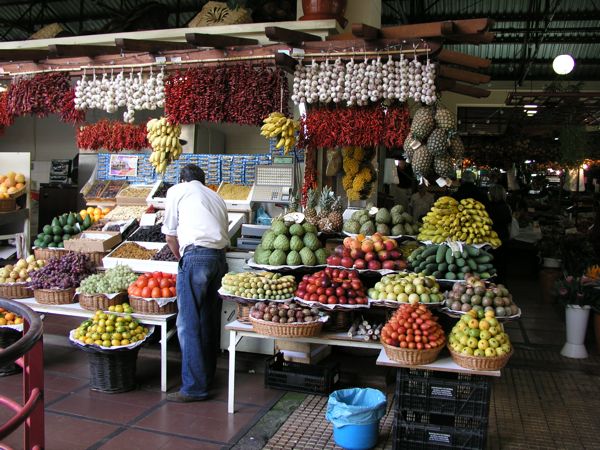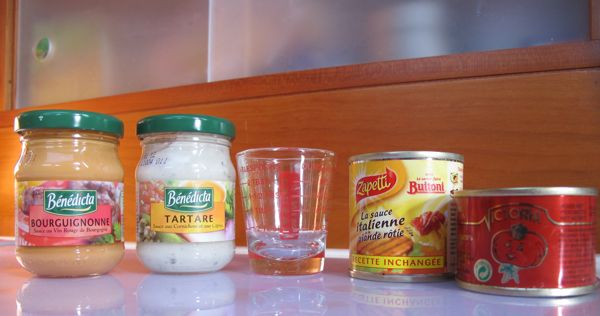Provisioning - Starting a Provisioning Notebook to Track Your Use of Supplies
By Sheryl Shard, copyright 2015. All rights reserved.

The delights of shopping in foreign markets.
The colourful market in the Portuguese island of Madeira.
Several months before our first major cruise in 1989, Paul and I started tracking our food and supply usage at home. This was the first step in designing a custom provisions list based on our individual needs and preferences.
We used a small three-ring binder with alphabetical index tabs which now contains complete and thorough lists of all our regular supplies. We entered items alphabetically in our binder every time we went grocery shopping and as we used things around the house and boat.
Over time, we developed a custom inventory of food items, cleaning and maintenance products, household goods and first aid supplies. We made notes beside each entry on how quickly we used things up, in what seasons we tended to eat more of certain foods and the changes in consumption rates of various products when guests stayed for a while.
This book is still our bible for provisioning. We consult it every time we go shopping to remind us of things we need. It is the foundation for our cruising inventory and provides reliable guidelines for how long we can cruise in isolation based on the supplies we have on board at the time.
Of course, when living aboard the boat, your regular eating habits and supply usage change somewhat due to factors such as the availability of certain products, your increased appetites due to physical activity and the galley equipment aboard your boat. However, we have found that our favourite foods at home are still the foundation of our provisions list for the boat.
As we travel, we discover new foods when we explore local markets and sample exotic cuisine in the ports we visit. In Spain, we developed a fondness for custard apples; in the Azores, two local women showed us how to prepare a delicious octopus stew; and in Brazil, a village boy introduced us to a refreshing bottled drink made from the fruit of the cashew tree. We make notes in our binder of any new “finds” and take them into consideration for future provisioning. I'm sure there is an app for this somewhere but my good old fashioned binder notebook that fits easily in my purse or backpack has served me well for years.

In France and the French islands of the Caribbean we discovered sauces in very small jars - handy when cooking for two.
Sometimes, we have to make substitutions or learn to live without products we enjoy at home when they are not available in the areas we are cruising. It was quite a shock to discover that peanut butter is only a staple in North America and difficult to find (or outrageously expensive) in most other countries. Now there is a big note in our provisioning binder to stock up on peanut butter when we’re going foreign!
We also take note of any changes we make in our regular routine while cruising. For example, we're real meat and potatoes people on shore but in many places around the world good meat is hard to find, expensive, or difficult to store. So when we are cruising, we are happier eating more stir-fries, stews and vegetarian meals (which are better for us anyway.)
Like many first-time cruisers, we initially made the mistake of loading the boat with canned goods we would never eat at home because books we had read said they stored well on a boat. If you don't eat canned corned beef or baked beans now, don't put them on the boat. Serving a crew food they hate will make them mutinous. On the other hand, nothing cheers up a wet miserable crew on a rainy night like a delicious meal of their favourite food or a surprise pack of a snack they love.
Building a list of food items and supplies you use regularly and annotating it with notes on how frequently you restock them, takes only a little time and starts you on the road to custom provisioning.
Go with What You Know
There are probably many things on your grocery list that you know how often to buy. For example, we know, without a doubt, that we go through 4 litres of milk every week whether living afloat or ashore. Start with the information that you know, and build from there. Any items you are uncertain about, make a point to observe and record your consumption rate in your provisioning notebook.
Of course, if you are planning a short-term cruise or cruising in an area where shopping is easy, you won’t need such in-depth records to plan your meals. But the longer and further you travel, the more helpful this kind of detailed information becomes.
When Paul and I were building our first boat, Two-Step, and our Atlantic cruise was a far-off dream, designing our stores list became an uplifting project after busy day's work. We'd quickly forget the stresses at the office as we added items to our provisioning binder and discussed the supplies we'd need for an ocean passage or a winter in the tropics.
Fuel your imagination as you create a master list of foods and supplies important to you!
Creating Your Own Provisioning Binder, Notebook or Spreadsheet
A good way to begin a custom provisions list for your cruise is to set up a binder, notebook or spreadsheet to record the supplies you use regularly. (There may even be an app for this that I haven't discovered yet. If you've found one you use, please let me know.)
Whenever you shop for food, household items or marine supplies, add the items to your book so you will have a master list of the common supplies you depend on.
The next step is to record the rate at which you consume them. This way, you will know how long things will last during your voyage and how often you will need to replace them.
A laundry marker and masking tape are useful tools to help you record the consumption rate of each item on your master list. Whenever you open a new tube of toothpaste, write that day's date on it with the laundry marker. When it's all used up, record the number of weeks it took to finish it.
Repeat the process a few times to get an average. For items that you can't or don't want to write on, such as paper towels, write the date on a piece of masking tape and stick it inside a nearby cupboard door.
Every couple of weeks, go through a cupboard in your kitchen, storage room, or the lockers in your boat to remind yourself of items that you don't buy regularly but like to have on hand. Certain spices, soup mixes, and cleaning products fit into this category for us. Add them to your lists and estimate how often you'll have to replace them if you are planning a long-term cruise.
These records are invaluable when provisioning for your cruise since they reflect your personal needs and preferences.
Check out more articles on Provisioning here.
Join our email list and get hints, technical articles and tips plus videos to help you achieve your cruising dreams.
- FREE 1/2 hour video on cruising the Exuma Islands in the Bahamas
- Technical Blog shows you how to deal with issues facing the cruising sailor
- Destination information from some of the world's best cruising areas
- Special discounts and promotions